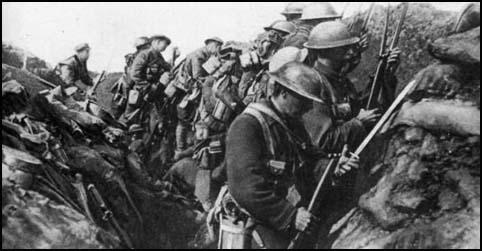Bayonet : First World War
At the end of the seventeenth century the French introduced the socket bayonet. This contained a sleeve fitting round the barrel and was locked into place with a slot and stud. This enabled the gun to be fired with the bayonet firmly secured in place. This type of bayonet was adopted by nearly all the Europeans armies.
The bayonet was originally a defensive weapon. Infantry standing two or three deep, who adopted a square formation, could defend their position against a cavalry charge. Bayonet charges were rarely attempted until the enemy was retreating.

The development of breech-loading rifles in the 19th century provided infantrymen with the firepower capable of beating off cavalry. After this, the bayonet turned from being primarily a defensive weapon to being a personal offensive weapon. The difficulties of fixing bayonets in battle led some armies to adopt permanently-attached bayonets which folded above or below the barrel of the rifle.
In the First World War all infantrymen were provided with bayonets. Most were of the standard knife variety, but the French preferred a needle bayonet and some German soldiers favoured a saw-bladed version. The bayonet was the infantryman's primary close combat weapon in trench warfare. However, some soldiers preferred to rely on clubs or knuckledusters in these situations. The importance of the bayonet as an offensive weapon was undermined during the war because of the increasing use of machine guns against an advancing army.
Primary Sources
(1) Bernard Montgomery wrote about his experiences in the First World War in his autobiography, The Memoirs of Field Marshal Montgomery (1958)
In my training as a young officer I had received much instruction in how to kill my enemy with a bayonet fixed to a rifle. I knew all about the various movements - right parry, left parry, forward lunge. I had been taught how to put the left foot on the corpse and extract the bayonet, giving at the same time a loud grunt. Indeed, I had been considered good on the bayonet-fighting course against sacks filled with straw, and had won prizes in man-to-man contests in the gymnasium.
(2) Arnold Ridley, The Train and Other Ghosts (1970c)
We were told that there was a pocket of resistance left over and that two advances had left this pocket and we were told that we would attack. We would get a five minute barrage, which we got, but Jerry and the German machine guns were firing, saying "we know you are coming over, come on, where are you?" Although the plans had gone wrong, the whistles blew and we went over the top just the same. At that time I was a bomber and we got down to the first trench...
I went round one of the traverses, as far as I remember, and somebody hit me on the head with a rifle butt. I was wearing a tin hat, fortunately, but it didn't do me much good. A chap came at me with a bayonet, aiming for a very critical part naturally and I managed to push it down, I got a bayonet wound in the groin. After that I was still very dizzy, from this blow on the head presumably. I remember wrestling with another German and the next thing I saw, it appeared to me that my left hand had gone. After that, I was unconscious...
I always remember my disappointment the next morning when I found that my hand was still on because I thought, well, if I lost my hand I'm all right, I shall live, they can't send me out without a hand again. I was 20 then, it's not altogether a right thought for a young man to hope that he's been maimed for life.
